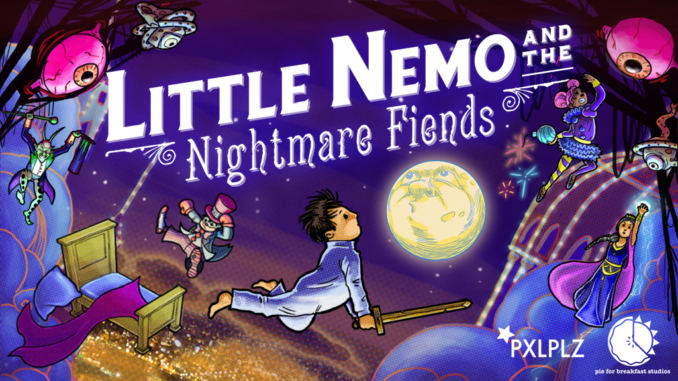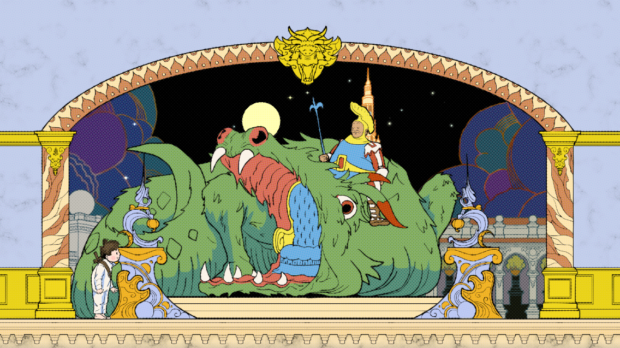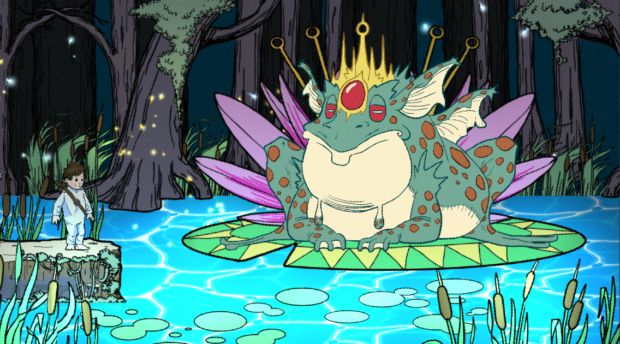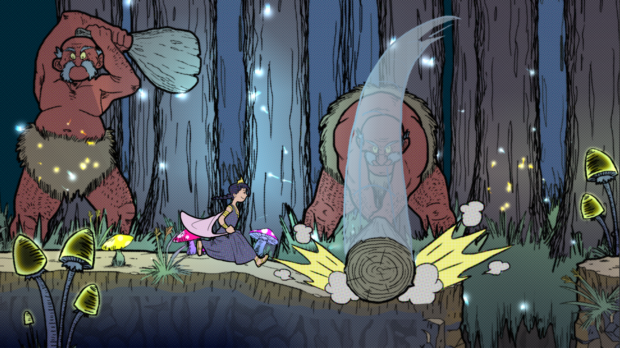
Review Fix chats with Chris Totten, Founder, Pie for Breakfast Studios, who discusses his upcoming game readying a Kickstarter, Little Nemo and the Nightmare Fiends.
For More Information on the Project, Head Here.

Review Fix: How was this game born?
Chris Totten: I’ve been a fan of Little Nemo for years, since seeing the NES game for the first time on the rental shelf at our grocery store when I was a kid (in that signature purple Capcom box!) I eventually learned about the original comic strips, which were published from 1905-1914 and again from 1924-1927. As someone with an architecture background, I loved the detailed backgrounds and unique panel layouts. The comic is old enough to be in the public domain, so I got to thinking about how it might become a cool video game, especially if we tried to recreate the comics’ art style. I also thought that Little Nemo’s world would fit the gameplay of games like Little Samson, which I felt deserved a second look. I wrote a design document down and kept it on the back burner for several years, but after talking about the idea with some friends at GDC in 2019, we decided to go for it.
Review Fix: What is your role in the game?
Totten: I’m the Creative Director for the project. I’m also the Lead Animator and Art Director. Eventually I’ll dive into Level Design too. On small teams you wear a lot of hats!
Review Fix: What has development been like?
Totten: Development has so far been a lot of hard work, but with some really great payoffs. This is going to be a richer game than most platformers. We’re following the formula of games like Little Samson, Shantae, or Magical Quest Starring Mickey Mouse, where the player can switch between characters or forms with different abilities. This creates a lot of extra design work tuning character abilities to work well together and making sure that levels work well with each character’s abilities. We’re doing all of the animation by-hand too. Even drawing on a computer, it’s A LOT of work: 5 seconds can take you a few weeks when you’re drawing each frame individually. It’s been hugely rewarding to see it all come together in the game though. There are these great moments of seeing a character like Flip use his swing ability, then saying “holy cow, this would be so cool if he did a backflip between swings†and you go and draw something wonderful.
Review Fix: What makes this Kickstarter special?
Totten: For us it’s a labor of love, but I suppose that everyone says that, right? I think what makes this project special is that we want to make a cool video game, but we’re also trying treating this like a work of
art. Some folks on our team are both university professors and game developers, so it’s both product and research. My own work is on finding the common elements between games and the arts, so I want to
create something that honors the historic contributions of McCay’s comics and animation while making them enjoyable by modern audiences. As a teacher, I’m always thinking, what are we doing when we make this game can be a lesson for other developers? So, we’re using it as an opportunity to experiment.

Review Fix: What attracted you the most to the Little Nemo brand?
Totten: As someone steeped in art and architectural history, but also who works in popular media, the comic is this melting pot of ideas. It’s a comic strip, but each strip is also a beautiful piece of art with elements of the Art Nouveau movement (popular in the late 19th and early 20th century – and you thought pixel art was retro!) The creator, Winsor McCay, was also a pioneer of early animation, so we wanted to explore hand-drawn animation with some of the techniques created by McCay and those he influenced to celebrate that element of the work.
Review Fix: How influenced have you been by the NES game?
Totten: When we started the project, we looked at each existing piece of Little Nemo media and figured out how much of each we could put in. We obviously can’t remake the NES game or base it on the 1980’s movie (neither of which is public domain), but we’re trying to find places to show fans of those works that we’re thinking about them. The NES game’s big explorable levels are a huge influence for us, so we’re trying to make a game where players will be able to explore more of the world as they unlock new characters and abilities.
Review Fix: What makes this game special?
Totten: The Little Nemo comics are about a boy exploring the world of his dreams. Sometimes they’re surreal, sometimes they’re scary, but they’re usually fantastic and beautiful. We want to create a similar feeling: as all developers do, we’re showing off a lot of footage of cool action gameplay things, but we’re also putting some of the comic’s sense of wonder in too, where the player can stop and admire a big creature or cool set piece. We’re hoping that the art style really drives that home.
Review Fix: Any fun stories or wild moments during development so far?
Totten: It’s hard to say – we’re all working remotely and having webcam meetings due to COVID-19. As a result there’s not a ton of “in the studio†stories. So I guess, the wild thing is making a game in the middle of a pandemic? That’s gone into the game in weird ways: there’s an animation on Nemo where he transitions from the face he makes during an attack into his normal idle pose face by taking a deep breath – I remember doing that in a moment of being overwhelmed. McCay was drawing newspaper cartoons during the 1918 Flu epidemic and drew the disease as a giant monster stomping on the city (well before there were kaiju movies), when we saw that we knew we HAD to include it as an enemy.

Review Fix: What were the major lessons learned?
Totten: In cartoon animation, there are principles for making characters feel “alive†– the 12 Principles of Animation. Some of these include making a small motion before taking an action to give a viewer’s brain time to expect the motion (“anticipationâ€) or adding extra motion to give the body a sense of weight (“follow-through.â€) In game animation, you can’t always do that because you need the character to react as soon as the button is pressed or it will seem like the game is lagging. Other game art styles can hide the lack of these elements in different ways (pixel art is lo-resolution enough that you don’t expect it, 3D games can include interpolation between animations), but hand-drawn sprites really suffer if you don’t have these principles. We had to almost re-interpret them so that you’d have a well-animated game that’s also responsive.
Review Fix: Do you think preserving older gameplay mechanics in new games is important?
Totten: When talking about this game, I focus on the Little Nemo connection a lot, but the original pitch was “what if we made a game like Little Samson, but with the Little Nemo characters?†The gameplay has evolved to include elements of other games, but that “switch between unique characters†idea is still there. For games like Little Samson where unclear rights make remakes or reissues unlikely, and which are rare enough that original cartridges go for obscene amounts of money, I think preservation through interpretation is important. We’re trying to do the same with the Little Nemo comic too: the original comics are great, but can also be tough to read for their very-not-okay depictions of non-white characters. Public domain gives us the opportunity to confront those elements of the original and welcome artists from underrepresented groups to help us interpret the comic in such a way that modern audiences can enjoy. One of our player characters, Peony, was created as a result of one such collaboration.
Review Fix: What’s your favorite memory as a gamer?
Totten: Playing games at friends’ or relatives’ houses were some of the best experiences I had growing up. Everyone thinks about couch multiplayer, but we also became really good at “group single player.†You could all take turns playing or involve people by giving them an issue of Nintendo Power and having them help you through the game by reading the maps. This extended to going to school and all talking about a game: sometimes a friend would give you the clues you needed to solve difficult puzzles. Elements from games that inspired that kind of play go into a lot of what I make.
Review Fix: How have your previous experiences in the industry helped this game?
Totten: The first answer is that I wouldn’t have put this team together if it weren’t for the networking I’ve done! We met through a program where developers sign up to be conference workers at the yearly Game
Developers Conference and it’s led to some really wonderful connections. The next is just experience working with intellectual property and creating interesting gameplay. We talk a lot about these happy memories of playing games, but we’ve spent years making games to learn how to make those very same experiences and deliver those strong emotions. While we’re a small team, we have collective decades of game making experience at different levels from academic, to indie, and even with big publishers. I’ve also written a few books about things like animation and level design, and we’re implementing ideas from that material into Little Nemo. This game is in good hands!

Review Fix: How do you want this game to ultimately be remembered?
Totten: As a dream come true! (Pun fully intended) Seriously though, I’m hoping that the games that I make, especially one like Little Nemo, can create those same “gather around the tv or talk to your friends about them†experiences that I had. I have kids now and the best part of making games like this has been having them run into my office to see what I’ve made next. They also push me as a designer because they don’t like everything that I like in games. I like action-y adventures with lots of areas to explore, but my oldest daughter really loves games where you slowly get to know a cast of characters (her current loves are
Animal Crossing: New Horizons and Stardew Valley ), and her younger sister loves games where you can be a trickster (her favorites are Untitled Goose Game or being Bowser Jr. in Bowser’s Fury). They’re definitely putting me to work coming up with ideas for this one!
Review Fix: What’s next?
Totten: As a side-project, I’m also working on a game called Kudzu that’s a kind of Zelda mixed with Metroid-style adventure about a gardener fighting a giant world-eating plant. I’m building it in an engine that lets you build games that can be played on original Game Boy hardware (by making a ROM file and loading it into an emulator or flashing it to a real cartridge!) My 7-year-old self is very happy!
Review Fix: Anything else you’d like to add?
Totten: Part of having experience in the industry is knowing how much game you can make with how many resources. We’re going to be funding the game through Kickstarter (the campaign is here:
https://www.kickstarter.com/projects/littlenemogame/little-nemo-and-the-nightmare-fiends) and we’d really love gamers’ help making this game a reality. If we can hit our funding goal, we’ll be able to make a really cool game with hand-drawn charm and lots of retro-style touches. To really create our full vision though, we’re hoping to hit a number of stretch goals to help us build the full list of levels, bigger maps, etc. If gamers give us a shot, we promise that they’ll be backing a project from folks who not only have a passion for this project, but also the knowledge and experience to deliver it.


Leave a Reply